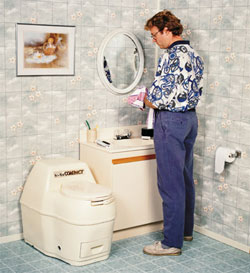| A composting toilet
breaks down waste into an inoffensive soil using
aerobic bacteria. Aerobic bacteria break down
waste quickly and only give off carbon dioxide,
water, and beneficial enzymes in this process.
However, to give them a good environment in
which to do their work, you need to provide
them with the following:
1. Plenty of Oxygen
This is in fact why they are called “aerobic”
bacteria. Without lots of oxygen, aerobic bacteria
just go dormant and don’t do a thing,
and anaerobic bacteria then take over. Anaerobic
bacteria produce the foul-smelling gasses that
we think of when we generally think of human
waste, and their breakdown process is much slower.
This is why the breakdown process itself has
no odor – there is none when aerobic bacteria
are employed.
Oxygen can be provided to the compost using
a number of means, including porous bulking
material and various mechanical devices.
2. Moisture
Without moisture, there is no vehicle by which
the bacteria can be transported through the
compost pile. If it is too dry, a number of
other things will start to happen as well. Toilet
paper won’t break down quickly and easily,
and the compost will start to harden. Generally
you don’t want to use the contents of
your composter as construction material, so
it definitely needs water to work.
Moisture is generally added to the compost
naturally through urination. In systems that
have low flush toilets, moisture level is rarely
a problem. In others, water may need to be added
from time to time to ensure that moisture levels
are between 40% and 60%.
3. Correct Bulking Material
This actually covers not just one item that you
need, but several. A good bulking mix will be
porous, which means that lots of oxygen will be
provided to the pile just by virtue of a loose
matrix in the bulk itself. Many composting toilet
manufacturers use wood shavings in order to ensure
porosity. Another often necessary ingredient is
peat moss, because it holds water (necessary in
dry toilet systems) and provides a very rich source
of carbon. A good carbon/nitrogen ratio is essential
to maintain in a composting toilet, because without
the carbon that you add through the bulking material,
the pile will generally be too nitrogen-rich and
the composting action will slow drastically.
A properly functioning composting system is
a mini-ecosystem with all of the proper elements
above working in conjunction with each other
to produce an excellent bio-reactor for breaking
down human waste.

Generally when you look into a composting toilet,
you will see what looks like soil. It really isn’t
offensive at all, and it doesn’t smell either.
I remember when I first saw a composting toilet
– it was about 10 years ago when I first
started working here. I was very curious as to
exactly how well the things worked that I was
involved with, so I snuck into the men’s
bathroom where the fully functional model was
located. I very gingerly crept up to the “throne”,
and lifted the seat. I was shocked. I was looking
at soil. I had worked myself up to looking at
something extremely different.
I couldn’t smell anything either. I even
put my nose up to the seat level and couldn’t
smell anything. I have seen many more since
then, in the field and out, and am always astounded
at how composting toilets manage to make human
waste smell like a forest floor. I also feel
very lucky to not only be with a company that
not only makes products that do exactly what
they say they are going to do, but a company
that is actively interested in protecting the
environment through promoting the use of composting
toilets.
This article refers mostly to my experience
with composting toilets, but I have tried to
make it as generic as possible. If you have
any comments on it, please feel free to post
them in the
forum.
|
